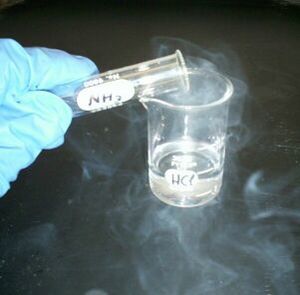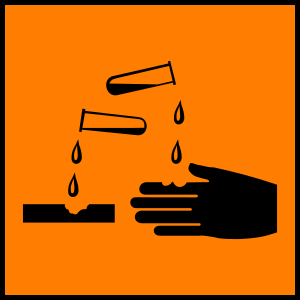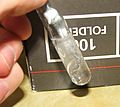Acid facts for kids

An acid is a substance that has many hydrogen ions (H+) and can donate them to another substance. These ions are usually protons. A strong acid will be able to let go of many or all of its ions while a weak acid will hold onto some of its ions.
A base is an acid's "chemical opposite." A base is a substance that will accept an acid's hydrogen atoms and will release hydroxide ions because it has many of them.
Contents
The pH Scale
Scientists use a special scale to measure how acidic or basic a liquid is. The pH scale matches how acidic or basic a substance is with a number on a scale. The lowest number is 0 (extremely acidic) and the highest number is 14 (extremely basic). The number 7 is neutral. An example of a liquid with a pH of 7 is distilled water. It is neither acidic nor basic.
Properties
Acids can have different strengths, based on how many hydrogen atoms they have. Stronger acids are dangerous and should never be handled without an adult's help. They can cause a chemical reaction that will burn your skin. (The same is true for strong bases.) Chemical burns need to be treated immediately.
Most acids have the following properties:
- Taste sour when they are eaten
- Can sting or burn the skin when they are touched
- Can corrode (eat away at) metals and skin
- Can be used during electrolysis (the splitting of other substances) because of its moveable ions
- Turn blue litmus paper red
- Turn red or orange on a universal indicator (a test to measure the pH of a liquid)
- Conduct electricity
Importance
Nucleic acids such as DNA and RNA contain the genetic code of living things. These special molecules give the characteristics that are passed down from parents to their children. DNA contains the detailed plans that tell how to build proteins that are made of amino acids.
Fatty acids are important sources of fuel for the body. They work with our cells to make energy.
Hydrochloric acid is a part of the gastric acid that is secreted in the stomachs of humans and many other animals. Hydrochloric acid helps digest food.
Some acids that can be found in nature are:
- Vinegar: one of the best-known acids; used in foods
- Nitric acid: used in rocket fuels and explosives
- Citric acid: found in fruits like lemons, grapefruits, and oranges
- Lactic acid: found in sour milk products like yogurt
- Sulfuric acid: a thick, clear liquid that can dissolve in water and melt weak substances; found in batteries.
Interesting facts about acids
- An acid is a substance that can donate one or more of its hydrogen ions to another substance.
- Strong acids let go of many or all of their ions.
- Weak acids hold onto some of their ions.
- The opposite of an acid is a base.
- Acids taste sour and can burn things like skin and even metal.
- Some of the most important and famous acids are DNA and RNA - the molecules that contain genetic code of living things.
- Acids can be found in the human body and nature.
Related pages
Images for kids
-
Zinc, a typical metal, reacting with hydrochloric acid, a typical acid
-
Acetic acid, a weak acid, donates a proton (hydrogen ion, highlighted in green) to water in an equilibrium reaction to give the acetate ion and the hydronium ion. Red: oxygen, black: carbon, white: hydrogen.
-
This is an ideal titration curve for alanine, a diprotic amino acid. Point 2 is the first equivalent point where the amount of NaOH added equals the amount of alanine in the original solution.
See also
 In Spanish: Ácido para niños
In Spanish: Ácido para niños







